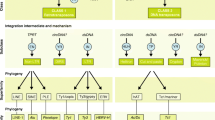Abstract.
The Oct-4 gene encodes a transcription factor that is specifically expressed in embryonic stem cells and germ cells of the mouse embryo. Cells that differentiate into somatic tissues lose Oct-4 expression. Regulation of Oct-4 gene transcription involves a TATA-less minimal promoter and two upstream elements: the proximal (PE) and distal enhancers (DE). We report here the nucleotide sequence of the 5′ upstream regulatory regions of the human and murine Oct-4 genes. A comparative alignment analysis between these regions and those of the bovine Oct-4 ortholog reveals four conserved regions of homology (CR 1 to 4) between these species (66–94% conservation). The 1A sequence within the mouse PE is located approximately half-way between CR 2 and CR 3. A putative Sp1/Sp3 binding site and the overlapping hormone responsive element (HRE) in CR 1 are identical in all three species. A high number of CCC(A/T)CCC motifs exhibit various levels of homology in these upstream regions. We discuss the importance of these and other sequences and present candidate factors that may bind and regulate Oct-4 gene expression.
Similar content being viewed by others
Author information
Authors and Affiliations
Additional information
Received: 12 September 2000 / Accepted: 5 December 2000
Rights and permissions
About this article
Cite this article
Nordhoff, V., Hübner, K., Bauer, A. et al. Comparative analysis of human, bovine, and murine Oct-4 upstream promoter sequences. Incorporating Mouse Genome 12, 309–317 (2001). https://doi.org/10.1007/s003350010279
Published:
Issue Date:
DOI: https://doi.org/10.1007/s003350010279




